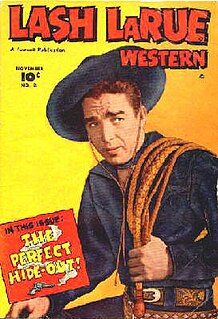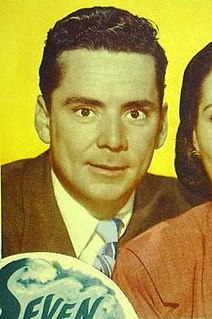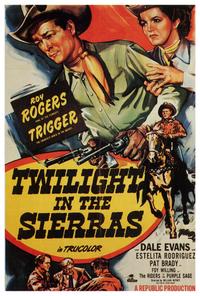
Unforgiven is a 1992 American Revisionist Western film directed, produced by, and starring Clint Eastwood in the lead role and written by David Webb Peoples. The film tells the story of William Munny, an aging outlaw and killer who takes on one more job, years after he had turned to farming. The film co-stars Gene Hackman, Morgan Freeman, and Richard Harris.

Roy Rogers was an American singer, actor, and television host. Following early work under his given name, first as co-founder of the Sons of the Pioneers and then acting, the rebranded Rogers then became one of the most popular Western stars of his era. Known as the "King of the Cowboys", he appeared in over 100 films and numerous radio and television episodes of The Roy Rogers Show. In many of his films and television episodes, he appeared with his wife, Dale Evans; his Golden Palomino, Trigger; and his German Shepherd, Bullet. His show was broadcast on radio for nine years and then on television from 1951 through 1957. His early roles were uncredited parts in films by fellow cowboy singing star Gene Autry and his productions usually featured a sidekick, often Pat Brady, Andy Devine, George "Gabby" Hayes, or Smiley Burnette. In his later years, he lent his name to the franchise chain of Roy Rogers Restaurants.
The Sons of the Pioneers are one of the United States' earliest Western singing groups. Known for their vocal performances, their musicianship, and their songwriting, they produced innovative recordings that have inspired many Western music performers and remained popular through the years. Since 1933, through many changes in membership, the Sons of the Pioneers have remained one of the longest-surviving country music vocal groups.

Dale Evans Rogers was an American actress, singer, and songwriter. She was the third wife of singing cowboy Roy Rogers.

William Lawrence Boyd was an American film actor who is known for portraying the cowboy hero Hopalong Cassidy.

Rex Elvie Allen, known as "the Arizona Cowboy", was an American film and television actor, singer and songwriter; he was also the narrator of many Disney nature and Western productions. For his contributions to the film industry, Allen received a motion pictures star on the Hollywood Walk of Fame in 1975, located at 6821 Hollywood Boulevard.

Bob Nolan was a Canadian-born American singer, songwriter, and actor. He was a founding member of the Sons of the Pioneers, and composer of numerous Country music and Western music songs, including the standards "Cool Water" and "Tumbling Tumbleweeds." He is generally regarded as one of the finest Western songwriters of all time. As an actor and singer he appeared in scores of Western films.

Kenneth Olin Maynard was an American actor and producer. He was mostly active from the 1920s to the 1940s and considered one of the biggest Western stars in Hollywood.

George Montgomery was an American actor, best known for his work in Western films and television. He was also a painter, director, producer, writer, sculptor, furniture craftsman, and stuntman. He was a boyfriend of Hedy Lamarr.

Alfred "Lash" LaRue was a popular western motion picture star of the 1940s and 1950s.

Charles John "Tim" Holt III was an American actor. He was a popular Western star during the 1940s and early 1950s, appearing in forty-six B westerns released by RKO Pictures.

Charles Robert Starrett was an American actor, best known for his starring role in the Durango Kid westerns. Starrett still holds the record for starring in the longest series of theatrical features: 131 westerns, all produced by Columbia Pictures.

Samuel Pack Elliott is an American actor. He is the recipient of several accolades, including a National Board of Review Award, and has been nominated for an Academy Award, two Golden Globe Awards, two Primetime Emmy Awards, and two Screen Actors Guild Awards.
A singing cowboy was a subtype of the archetypal cowboy hero of early Western films. It references real-world campfire side ballads in the American frontier, the original cowboys sang of life on the trail with all the challenges, hardships, and dangers encountered while pushing cattle for miles up the trails and across the prairies. This continues with modern vaquero traditions and within the genre of Western music, and its related New Mexico, Red Dirt, Tejano, and Texas country music styles. A number of songs have been written and made famous by groups like the Sons of the Pioneers and Riders in the Sky and individual performers such as Gene Autry, Roy Rogers, Tex Ritter, Bob Baker and other "singing cowboys". Singing in the wrangler style, these entertainers have served to preserve the cowboy as a unique American hero.
Monte Hale was an American B-Western film star and country musician.

Russell "Lucky" Hayden was an American film and television actor. He is best known for his portrayal as Lucky Jenkins in Paramount's popular Hopalong Cassidy film series.

Twilight in the Sierras is a 1950 American Trucolor Western film directed by William Witney and starring Roy Rogers and his horse Trigger, along with Dale Evans, Estelita Rodriguez, and Pat Brady.

Cowboys & Aliens is a 2011 American science fiction Western action film directed by Jon Favreau and starring Daniel Craig, Harrison Ford, Olivia Wilde, Sam Rockwell, Adam Beach, Paul Dano, and Noah Ringer. The film is based on the 2006 Platinum Studios graphic novel of the same name created by Scott Mitchell Rosenberg. The plot revolves around an amnesiac outlaw (Craig), a wealthy cattleman (Ford), and a mysterious traveler (Wilde) who must ally to save a group of townspeople abducted by aliens. The screenplay was written by Roberto Orci, Alex Kurtzman, Damon Lindelof, Mark Fergus, and Hawk Ostby, based on a screen story by the latter two along with Steve Oedekerk. The film was produced by Brian Grazer, Ron Howard, Kurtzman, Orci, and Rosenberg, with Steven Spielberg and Favreau serving as executive producers.
The Gambler is a series of five American Western television films starring Kenny Rogers as Brady Hawkes, a fictional old-west gambler. The character was inspired by Rogers' hit single "The Gambler".

Western comics is a comics genre usually depicting the American Old West frontier and typically set during the late nineteenth century. The term is generally associated with an American comic books genre published from the late 1940s through the 1950s. Western comics of the period typically featured dramatic scripts about cowboys, gunfighters, lawmen, bounty hunters, outlaws, and Native Americans. Accompanying artwork depicted a rural America populated with such iconic images as guns, cowboy hats, vests, horses, saloons, ranches, and deserts, contemporaneous with the setting.
















